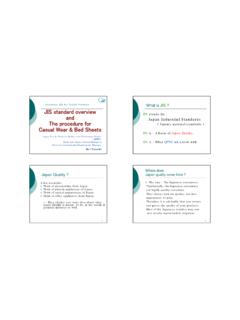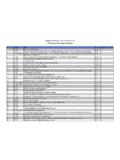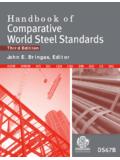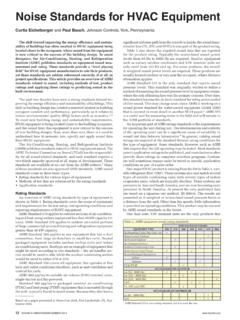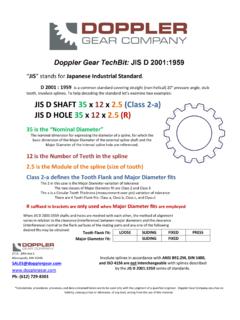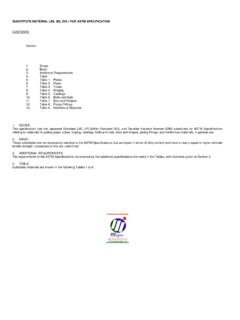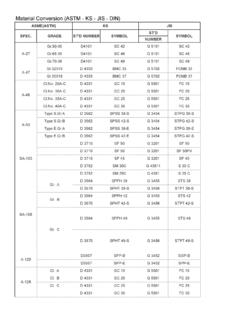Transcription of JAPANESE INDUSTRIAL STANDARDS FOR THE …
1 Copyright SFA - InterNoise 2000 The 29th International Congress and Exhibition on Noise Control Engineering27-30 August 2000, Nice, FRANCEI-INCE INDUSTRIAL STANDARDS FOR THEDETERMINATION, DECLARATION AND VERIFICATIONOF NOISE EMITTED FROM MACHINERY ANDEQUIPMENT - STATE OF THE ARTSM. KoyasuChiba Institute of Technology, Tsudanuma 2-17-1, 275-0016, Narashino, JapanTel.: +81-3-3356-7566 / Fax: +81-3-3356-7566 / Email: INDUSTRIAL STANDARDS , MACHINERY NOISE, INTERNATIONAL CONFORMITYABSTRACTIn Japan, establishments of national STANDARDS for the determination of noise emitted from machineryand equipment are in progress, especially during past five years. These STANDARDS are divided into twogroups: basic STANDARDS and individual STANDARDS .
2 Basic STANDARDS for the determination of sound powerlevels and emission sound pressure levels are essentially in conformity with corresponding internationalstandards. On the other hand, individual STANDARDS for specific machinery and equipment are not nec-essarily conformed with corresponding international and national STANDARDS . In this paper, backgroundof these situations is described in - INTRODUCTIONIn Japan, methods for measurement and evaluation of noise have been standardized in JAPANESE Indus-trial STANDARDS (JIS). These STANDARDS are divided into three parts: (1) STANDARDS on the methods formeasurement of noise emitted by machinery, equipment and other sound sources; (2) STANDARDS on themethod for measurement of environmental noise; (3) STANDARDS on measurement instruments.
3 The firstgroup STANDARDS are further divided into two groups basic STANDARDS and specific STANDARDS , whichspecify test codes to be adopted for specific sound Agency of INDUSTRIAL Science and Technology, MITI, usually leaves the preparation of new draftstandards and/or the revision of existing STANDARDS to appropriate organizations. As to the basic stan-dards on noise, Acoustical Society of Japan or INCE/Japan draft the basic STANDARDS on hoctechnical committees are established in the respective societies, and experts prepare draft STANDARDS inthese recently, these national STANDARDS have not necessarily been in harmony with corresponding in-ternational STANDARDS .
4 Due to strong requirements from the World Trade Organization (WTO), theJapanese government made a basic policy decision in 1995; that all JAPANESE INDUSTRIAL STANDARDS shallhave complete conformity to the international STANDARDS , such as those published by ISO, IEC etc. Thetarget date was the end of 1998 March. Thus, the revision of existing STANDARDS and the preparation ofnew STANDARDS were almost this paper, state of the arts on the JAPANESE INDUSTRIAL STANDARDS in the field of the methods formeasurements of noise emitted from machinery and equipment and of the relevant STANDARDS will - BASIC CONSTRUCTION OF STANDARDSThe JAPANESE INDUSTRIAL STANDARDS on the methods for measurements of noise emitted from machineryand equipment are classified into the following two groups: STANDARDS which specify the methods for measurements of noise.
5 In these STANDARDS , the titleincludes the term such as measurement or SFA - InterNoise 20002 STANDARDS which specify the specifications for products on machinery and equipment. Amongvarious specifications, a clause concerning noise is first group of STANDARDS is divided further into two sub-groups: One is the so-called basic prescribe the general rules for the measurement of emitted noise without any description on specifictype of machinery and equipment. Another group of STANDARDS describes the method for measurementof specific type of machinery and second group of STANDARDS is product standard. The titles of STANDARDS show only the names ofproducts. As one of the performance specifications, noise limit is prescribed.
6 Most of these standardshave specifications on the method for the following sections, details of STANDARDS are described for respective - BASIC STANDARDS FOR THE DETERMINATION OF SOUND POWER LEVELSAND THE MEASUREMENT OF EMISSION SOUND PRESSURE - Determination of sound power levelsBasic JIS STANDARDS for the determination of sound power levels of noise sources are summarized in STANDARDS for sound pressure method, JIS Z 8732, Z 8733 and Z 8734, were already published during1986 and 1988, respectively. Revised draft STANDARDS are prepared as the translation of correspondingISO STANDARDS . They will be published before the end of STANDARDS for the determination of sound power levels by sound intensity method, JIS Z 8736-1and Z 8736-2 were newly published.
7 They are basically translation STANDARDS with corresponding ISOstandards. Only the conformity on the terminology and definitions between two STANDARDS was numbermeasuredquantitymeasurementenviron mentaccuracygradecorresponding ISOstandardZ 8732:xxxxsound pressurefree-field & hemifree-fieldprecisionISO/DIS 3745Z 8733:xxxxsound pressureapproximatelyhemi free-fieldengineeringISO 3744:94Z 8734:xxxxsound pressurereverberantprecisionISO 3741:99Z 8736-1:99sound intensityanyprecision,engineering,survey ISO 9614-1:93Z 8736-2sound intensityanyengineering,surveyISO 9614-2:96 Table 1:Determination of sound power connection with above STANDARDS , draft JIS Z XXXX was prepared for the reference sound is also the complete translation standard with ISO 6926 - Measurement of emission sound pressure levelsThe older standard JIS Z 8731, which was originally published in 1957, specified the method for mea-surement of A-weighted sound pressure level of noise emitted from machinery and equipment.
8 However,in the overall revision of JIS Z 8731 in 1983, the scope of this standard was restricted to the measurementof environmental noise and the provision concerning the measurement of machinery noise was completelydeleted. Until recently, there has not been basic standard in Japan on the method for measurement ofemission sound pressure level of machinery and draft STANDARDS were prepared which correspond to the ISO 11200 series. Table 2 shows the con-struction of these STANDARDS which are complete translation STANDARDS , respectively. These STANDARDS willbe published before the end of numnermeasurementenvironmentaccuracy gradeCorresponding ISOstandardZ 8737-1:xxxxessentially hemifree-fieldengineeringISO 11201:95Z 8737-2:xxxxIn situsurveyISO 11202:95 Table 2:Measurement of emission sound pressure SFA - InterNoise 200034 - STANDARDS FOR SPECIFIC MACHINERY AND - Measurement standardsThere are a number of standard which prescribe the method for measurement of noise emitted fromspecific family of machinery and equipment.
9 The titles of these STANDARDS include the term method formeasurement of noise or similar expressions. JAPANESE INDUSTRIAL STANDARDS for specific machinery andequipment are classified according to the machinery titles of these STANDARDS are listed below:[Civil Engineering and Building Engineering] A 1424-1-98: Method for laboratory tests on noise emission from appliances and equipment usedin water supply installations Part 1: Measurement method A 1424-2-98: Method for laboratory tests on noise emission from appliances and equipment usedin water supply installations Part 2: Mounting and operating conditions for draw-off taps andmixing valves A 1708-94: Method of test for noise of equipment units for dwellings A 8305-88.
10 Method for the measurement of airborne noise emitted by construction equipmentintended for outdoor use[Machinery] B 1548-95: Rolling bearing Measuring methods of A-weighted sound pressure level B 1753-99: Acceptance code for gears Determination of airborne sound power levels emitted bygear units B 6004-80: Method of sound level measurement for machine tools B 6406-91: Mechanical press Methods of measurement of A-weighted sound pressure level B 6521-78: Method of measurement for noise emitted by wood working machinery B 8005-98: Reciprocating internal combustion engines Measurement of emitted airborne noise Engineering method and survey method B 8310-85: Methods of A-weighted sound pressure level measurement for pumps B 8346-91: Fans, blowers and compressors Determination of A-weighted sound pressure level B 8350-89: Methods of noise level measurement for oil hydraulic pumps and motors B 9064-98: Method of sound level measurement for INDUSTRIAL sewing machine[Automobile] D 1024-99: Acoustics Measurement of noise emitted by accelerating road vehicles Engineeringmethod D 1026-87: Measurement of noise emitted by stationary road vehicles D 1041-87: Method of acoustic test of horns for motor cycles D 1616-95: Road vehicles Measurement methods of noise emitted by exhaust systems D 8301-93.
